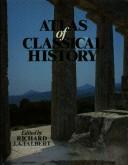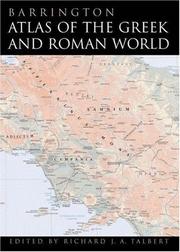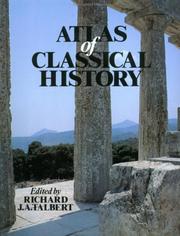| Listing 1 - 10 of 30 | << page >> |
Sort by
|

ISBN: 0709924216 0709924488 9780709924487 9780709924210 Year: 1985 Publisher: London Croom Helm
Abstract | Keywords | Export | Availability | Bookmark
 Loading...
Loading...Choose an application
- Reference Manager
- EndNote
- RefWorks (Direct export to RefWorks)
Book
ISBN: 0691054002 9780691054001 Year: 1984 Publisher: Princeton : Princeton University Press,
Abstract | Keywords | Export | Availability | Bookmark
 Loading...
Loading...Choose an application
- Reference Manager
- EndNote
- RefWorks (Direct export to RefWorks)
Rome. --- Rome --- Politics and government --- Politique et gouvernement --- Rome - Politics and government - 30 BC-284 AD

ISBN: 0691049459 069103169X 9780691031699 9780691049458 Year: 2000 Publisher: Princeton (N.J.) Princeton university press
Abstract | Keywords | Export | Availability | Bookmark
 Loading...
Loading...Choose an application
- Reference Manager
- EndNote
- RefWorks (Direct export to RefWorks)
Entreprise UAI 48 : Atlas du Monde Grec et Romain
912 <09> <37> --- 912 <09> <38> --- 930.9 --- 931: 912 --- Cartografie. Kaarten. Plattegronden. Atlassen--Geschiedenis van ...--Rome. Oud-Italië --- Cartografie. Kaarten. Plattegronden. Atlassen--Geschiedenis van ...--Oud-Griekenland --- Wereldgeschiedenis --- Oude geschiedenis--in het algemeen-:-Cartografie. Kaarten. Plattegronden. Atlassen --- Civilization, Classical. --- Greece --- Rome --- 931: 912 Oude geschiedenis--in het algemeen-:-Cartografie. Kaarten. Plattegronden. Atlassen --- 930.9 Wereldgeschiedenis --- Antiquity --- Civilization, Greco-Roman --- History, Ancient --- Historical geography --- Cartes --- Early works to 2100 --- Antiquities --- Antique, the --- Civilization, Greco-Roman - Maps. --- History, Ancient - Maps.

ISBN: 0415034639 9780415034630 0203405358 9780203405352 0203326679 9780203326671 9781134966530 1134966539 9781134966486 1134966482 9781134966523 1134966520 9781138127531 1138127531 Year: 1985 Publisher: London New York Routledge
Abstract | Keywords | Export | Availability | Bookmark
 Loading...
Loading...Choose an application
- Reference Manager
- EndNote
- RefWorks (Direct export to RefWorks)
History, Ancient --- Histoire ancienne --- Maps --- Cartes --- Historical geography --- Classical geography --- Geography, Ancient --- History, Ancient. --- Maps. --- Historical geography - Maps --- Classical geography - Maps --- Geography, Ancient - Maps
Book
ISBN: 9780190273484 0190273488 9780190273491 0190273496 019027350X 9780190273507 Year: 2016 Publisher: Oxford Oxford University Press
Abstract | Keywords | Export | Availability | Bookmark
 Loading...
Loading...Choose an application
- Reference Manager
- EndNote
- RefWorks (Direct export to RefWorks)
Talbert investigates miniature sundials which can be adjusted for the owner's whereabouts. They incorporate a list of locations and latitudes for ready reference, data that offers insight into Romans' worldviews. To some perhaps, these sundials were primarily symbols of scientific awareness as well as imperial mastery of time and space.
Sundials --- Time measurements --- Cadrans solaires --- Temps --- History --- Mesure --- Histoire --- Clocks and watches. --- Sundials. --- Time measurements. --- Clocks and watches --- Time --- Measurement --- Physical measurements --- Vibration --- Timepieces --- Watches --- Chronology --- Horology --- House furnishings --- Clock and watch making --- Gnomonics --- Hours (Time) --- Sun-dials --- Dialing
Book
ISBN: 0226789403 9780226789408 Year: 2012 Publisher: Chicago London
Abstract | Keywords | Export | Availability | Bookmark
 Loading...
Loading...Choose an application
- Reference Manager
- EndNote
- RefWorks (Direct export to RefWorks)
Ancient Perspectives encompasses a vast arc of space and time-Western Asia to North Africa and Europe from the third millennium BCE to the fifth century CE-to explore mapmaking and worldviews in the ancient civilizations of Mesopotamia, Egypt, Greece, and Rome. In each society, maps served as critical economic, political, and personal tools, but there was little consistency in how and why they were made. Much like today, maps in antiquity meant very different things to different people. Ancient Perspectives presents an ambitious, fresh overview of cartography and its uses. The seven chapters range from broad-based analyses of mapping in Mesopotamia and Egypt to a close focus on Ptolemy's ideas for drawing a world map based on the theories of his Greek predecessors at Alexandria. The remarkable accuracy of Mesopotamian city-plans is revealed, as is the creation of maps by Romans to support the proud claim that their emperor's rule was global in its reach. By probing the instruments and techniques of both Greek and Roman surveyors, one chapter seeks to uncover how their extraordinary planning of roads, aqueducts, and tunnels was achieved. Even though none of these civilizations devised the means to measure time or distance with precision, they still conceptualized their surroundings, natural and man-made, near and far, and felt the urge to record them by inventive means that this absorbing volume reinterprets and compares.
Cartography --- Geography, Ancient. --- Surveying --- History. --- history, historical, maps, mapmaking, cartography, cartographer, mesopotamia, egypt, greece, rome, italy, africa, fertile crescent, time period, era, europe, millennium, bce, civilization, culture, cultural, antiquity, analysis, ptolemy, world, global, alexandria, mesopotamian, city planning, roman, aqueducts, roads, surveying, essay collection, anthology.
Book
Year: 2000 Publisher: Princeton Princeton university press
Abstract | Keywords | Export | Availability | Bookmark
 Loading...
Loading...Choose an application
- Reference Manager
- EndNote
- RefWorks (Direct export to RefWorks)
Book
ISBN: 9780429485688 9781472457820 9780367496654 Year: 2019 Publisher: London Routledge
Abstract | Keywords | Export | Availability | Bookmark
 Loading...
Loading...Choose an application
- Reference Manager
- EndNote
- RefWorks (Direct export to RefWorks)
Challenges of Mapping the Classical World collects together in one volume fourteen varied items written by Richard Talbert over the past thirty years. They cohere around the theme of mapping the classical world since the nineteenth century. All were originally prompted by Talbert’s commission in the late 1980s to produce a definitive classical atlas after more than a century of failed attempts by the Kieperts and others. These he evaluates, as well as probing the Smith/Grove atlas, a successful twenty-year initiative launched in the mid-1850s, with a cartographic approach that departs radically from established practice. Talbert’s initial vision for the international collaborative project that resulted in the Barrington Atlas of the Greek and Roman World (2000) is presented, and the successive twice-yearly reports on its progress from 1991 through to completion are published here for the first time. A further item reflects retrospectively on the project’s cartographic challenges and on how developments in digital map production were decisive in overcoming them. This volume will be invaluable to anyone with an interest in the development and growing impact of mapping the classical world.
Classical geography --- Cartography --- History
Book
ISBN: 1400849764 Year: 1984 Publisher: Princeton, New Jersey : Princeton University Press,
Abstract | Keywords | Export | Availability | Bookmark
 Loading...
Loading...Choose an application
- Reference Manager
- EndNote
- RefWorks (Direct export to RefWorks)
Richard J. A. Talbert examines the composition, procedure, and functions of the Roman senate during the Principate (30 B.C.-A.D. 238). Although it is of central importance to the period, this great council has not previously received such scholarly treatment. Offering a fresh approach to major ancient authors (Pliny and Tacitus in particular), the book also draws on inscriptions and legal writers never before fully exploited for the study of the senate.
Rome. --- Rome --- Politics and government
Book
ISBN: 0691102384 Year: 1984 Publisher: Princeton University Press
Abstract | Keywords | Export | Availability | Bookmark
 Loading...
Loading...Choose an application
- Reference Manager
- EndNote
- RefWorks (Direct export to RefWorks)
| Listing 1 - 10 of 30 | << page >> |
Sort by
|

 Search
Search Feedback
Feedback About UniCat
About UniCat  Help
Help News
News